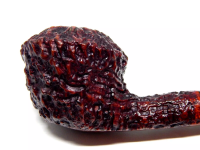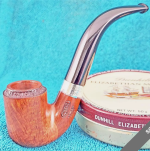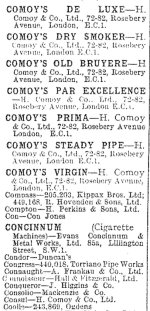Hello Gentlemen. This is Chance, the Chance who posted the aforementioned Comoy's in discussion. While it's my first post here, I do follow a few threads on the forums here, this being one of them, and this one finally got me out of my years long lurker mode and actually posting.
When push comes to shove, I would almost always defer to Mr. Guss in all things historical pipes. I absolutely recognize that his knowledge and research abilities dwarf my own. To be honest, I'm not even sure I disagree with him on this pipe, though I would be interested in his thoughts on a couple of items I will get to shortly.
My main purpose in writing this is to VERY gently push back against the statement that I may have taken (or ever would take) some "poetic license" in my listings. I try VERY hard to present the most accurate descriptions I can, and would never lean towards presenting something as more than it is. This is not to say I don't occasionally make mistakes, I have, but I try to be as researched as I can and to present things as accurately as I can. Saying that, I will present sources of my information used for this listing. If I've put them together incorrectly, I assure you it was not intentional "poetic license".
First, pipedia states Comoy's was first to use the term LONDON MADE, and that this style (block & straight LONDON over MADE) was the first style used by them, starting about 1902 and giving way to the Rubgy style in the 1920s.
Second, Pipedia also states the the HC in a cartouche started in 1904.
Third, regarding the orific or slotted button, in
this thread here there is discussion of a similar pipe, in which it was stated that:
1) a slotted stem was in use at the time, and thus is not definitive for later manufacture. Being that Mr. Guss was involved in that thread, and didn't dispute the assertion that a slot was not definitive, I assumed there was no disagreement from him on that point. I recognize that is making an assumption from silence, which obviously is not in itself definitive, my point is only that strong evidence was presented and there was no dispute of the matter.
2) the Comoy's name was not used prior to 1913. Based on info seen here, I concede that this may not be the case, my only point in bringing it up is to show I wasn't just making things up whole cloth. However the markings on that pipe are almost identical this one, except that this one says CONSUL where that one has HC over the COM stamp, which it seems logical to mean HENRI COMOY. Since it was stamped HC rather Comoy's, I believed that lent credibility to the idea that Comoy's was not being stamped on their pipes yet.
In order to show my respect for Mr. Guss' research, I thank you for pointing out that Consul was a second line from Comoy's. Here I was obviously incorrect in my assertion that it was a store name. Because I was unable to find any information regarding this specific line (hats off to you you for the find on the Tobacco Yearbook!), combined with with this line on Pipedia regarding a pipe hallmarked 1904, "(Stamped on the side “J.R.” in an oval and “LONDON MADE”. (Comoy’s supplied many shops that had their name stamped on the side of the pipe. J.R. was obviously one.)" were my reasons for the jump to Consul being a store stamp. Again, I acknowledge this was incorrect.
I hope this information is sufficient to show that I really do try to be as informed and accurate as possible. As this was the best information I could find (and I tried hard!) and that there is no reason based on the COM stamp to put this pipe past "the 1920s", combined with it's being near identically stamped (only the name is different) to a pipe in the other thread in which Mr Guss did not dispute it's dating to 1902-1912, I felt I could be confident in my dating of this pipe. If my conclusion was incorrect, it was not because I was taking license, but rather the best information I could find at the time may not have been as conclusive as I'd believed.
I would very much be interested in hearing further (especially from Mr. Guss, but also from anyone else) why the dating would be outside of the time I asserted though. I think it would certainly be safe to say it was made before the shift in the COM stamp, and based on it's similarity to the other pipe, would it not be likely to date to the same approximate time? I truly welcome the discussion and any other criticism.
Kind regards,
Chance













